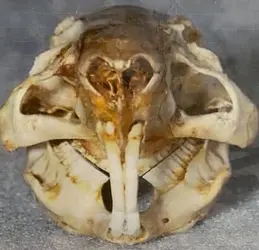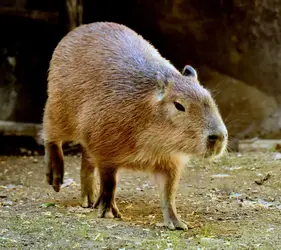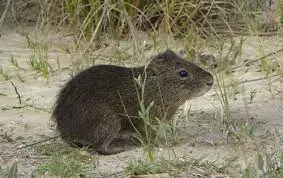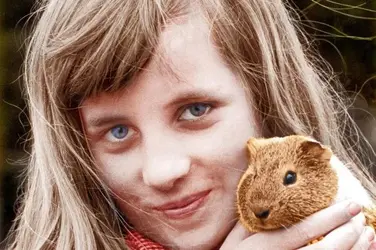3 Reproductive and biological facts
Sexual maturity and reproductive cycle
Males: between 3-5 weeks
(Please separate baby boars at 3 weeks old/250g of weight!)
Females: between 4-6 weeks
Earliest documented sibling pregnancy: 24 days
Sows come into season again within hours of giving birth. Their oestrous cycle (how often they come into season) is 15-17 days.
A pregnancy lasts between 58-75 days. Guinea pigs can have up to 10 babies in one litter (the largest fully surviving litter is 8 pups), but normal are 1-6 pups.
Guinea pigs have the longest pregnancy and smallest number of babies of all rodents. But a long pregnancy and big babies mean that about 20-25% of pregnancies with the death of pups and/or their mothers because of their large size and the high risk this poses.
Newborn pups are precocious, i.e. born fully furred, with their eyes open, their teeth fully developed, able to follow their mother and to nibble on solid foods straight away although they depend on their mother's milk for 3-4 weeks when they are weaned by their mothers and become sexually active straight away.
They learn what is safe to eat and how to drink from their elders and continue to rely on them for guidance and socialisation until they reach the teenage months and they become parents themselves.
If babies are not properly sexed and any boars separated from sows at 3 weeks of age, they can multiply and get our of hand very quickly!
Boar testicles start descending coming up to around 4 months of age, which signals the start of the teenage, which is characterised by big testosterone spikes (ca. 4-14 months). They are usually fully descended by 6 months which coincides with the time testosterone production is at a lifetime high. Unlike in humans, the descent of the testicles doesn't signal sexual maturity; it happens well after the fact!
End of reproductive age for males and females:
no end until death. There is no menopause for guinea pigs; but the older they are, the higher the risk of death for the sow and any pups, especially first time mums!
Body facts
Senses
Guinea pigs have much finer hearing than humans; they can hear higher sounds than humans, which is not surprising, considering that they have evolved in dense grasslands where hearing is much more vital than sight!
Accordingly, guinea pigs can see very clearly in colour on short distances (reddish shades are somewhat differently perceived compared to humans), but over larger distances they only react to sudden movements. This is important when trying to avoid spooking them.
Like most prey animals, their eyes cover a wide area to the sides and above, but they cannot see in front of their nose. This area is covered by a strong sense of smell and by their whiskers, which are an additional sense.
When guinea pigs eat, they find their morsels by smell as they cannot see what they are picking up. This is also the reason why they can mistakenly bite into a finger of yours that smells of fresh veg!
Since they are prey animals, guinea pigs will sleep with their eyes fully closed only if they are absolutely exhausted or feeling totally safe where they are. Mostly you can spot a sleeping piggy by the far-away look in its eyes.
Teeth
Like with all rodents, their teeth grow constantly and have to be worn down through eating in order to avoid them overgrowing. In fact, guinea pigs seem to have the fastest growing teeth of all rodents!
In a healthy dental system, the front teeth are self-sharpening and don't need any attention. The molars and premolars at the back are ground down through the silica in grass and hay; this is why hay should make up to 80% of the daily food intake.
Their guts have also evolved to cope specifically with their natural diet; too rich a diet of vegetables and fruit leads to fermentation in the gut, and long term health is compromised!
 Digestive system
Digestive system
Guinea pigs have to eat some of their poos to digest twice in order to break down the tough fibrous hay/grass that is what they should mostly eat - over 80% of their daily food intake with only a little veg and just a tablespoon of pellets each day. A little fruit should only be on the menu once or twice a week - together with carrots, fruit count as treats.
The more hay/fresh grass guinea pigs eat, the healthier they will be and the longer it has a chance at living.
Veg, herbs, wild and garden/fresh and dry forage, pellets/dry mix and any treats all together only replace the supplementary role that wild forage used to have -
Two runs through the gut means that guinea pig eat the poos after the first run through the gut for a second run but unlike rabbits they do not separate out the digestive bits of fibre from the first run through the caecum (caecotrophs). They are coprophages (poo eater) who have a larger and less efficient gut compared to rabbits and other lagomorphs for that reason; their caecum is a lot larger (it contains about two thirds of all food in the digestive tract at any time) but it only retains the digestive gut bacteria via a so called mucus trop in caecum without separating any grass fibre. The poos after the first run are generally a bit softer but otherwise not different.
Piggies unable to eat poos after the first run for the longer term (impaction in boars; athritis or chronic illness) will profit from additional vitamin B complex (they are making use of 7 of the 10 B vitamins compared to the 3 that rabbits use) to minimise weight loss.
Unlike rabbits, guinea pigs can't make their own vitamin C and need to have have vitamin C in their diet; it is wirth keeping in mind that vitamin C is in any fresh growing grass (the reason why they never had the need to make their own in the first place), it is also in good quality pellets, most probiotics and and in any recovery formula, so even if your piggy is not able to eat their preferably creen veg and herb mix, they will still get vitamin C with their support feed. Since the body will adapt to higher levels of vitamin C, it is more effective (apart from a well balanced normal diet) to conduct a 2-3 booster course whenever your piggy is actually ill.
On average it takes about 22 hours for food to pass through the digestive tract from one end to the other (it can vary between 8-30 hours). This means that any poo output is always lagging 1-2 days behind when you only health monitor by poo watching instead of an instant feedback on any food intake by weighing once weekly for ealthy or daily for ill piggies. It is also worth noting that the difference between before and after a larger meal can be 30-40g with the difference between a full and an empty bladder making 10g. Because of that daily swing in weight we are talking about weight loss only from 50g onwards (about 2 oz). We also recommend to weigh ill guinea pigs always at the same time of the day; first thing in the morning is ideal to monitor any ongoing weight loss.
Because guinea pigs have evolved to live off nutrionally rich, but difficult to extract grass/hay fibre which should make at least three quarters of what they eat in a day, they need eat a lot for their size; they also make a lot of poos - which is the sign of a health piggy!
Guinea pigs rely on a steady supply of food; they cannot fast for more than a day at the very most or they will die. A guinea pig that is not eating much or nothing at all needs to be syringe fed with fibrous recovery food and water (only water will not keep it going). It needs to see a vet promptly or its guts will start to slow down after a day and then shut down; the guinea pig will die when that happens.
Wiebke's Guide to Poops
Vomiting reflex
Guinea pigs don't have a vomit reflex (typical for all rodents) - what has gone down has to come out at the other end! To avoid poisoning, they have double the amount of taste buds than humans and a multiple of that of cats. They learn what is safe to eat from the elders in their group; that is why you can often see babies snatching food from their mouths. They also learn where and how to drink from by mimicking other piggies.
Feet
Guinea pigs have four digits on their front feet and three on their back feet. They use the front feet to carry the main weight of the body and the back feet as springs when they run very fast.
Nipples and sexing
Males and females have both got 2 nipples that look the same. Young babies often look very similar when they are born and are often mis-sexed by shop personnel or breeders which can result in unplanned pregnancies.
Here is how you can sex guinea pigs safely:
Sexing Guide
How you can learn to spot what is normal and what not in a guinea pig body:
Guinea pig body quirks
Illustrated Sexing Guide
Heart rate and breathing
Guinea pigs have a much faster heart rate than we humans.
They cannot breathe through their mouths much, which is why every little obstruction in their narrow airways is very audible. They have also a comparatively small respiratory system - most of their body is taken up by the digestive system.
Regulating the body temperature
Guinea pig regulate their body temperature via the blood flow through their ears and hairless extremities (red ears and all red feet means that they are feeling hot and are shedding heat via increased blood flow and widened blood vessels).
They do not sweat or pant. Any dampness in the fur comes from condensation in a confined, not well aired space. Guinea pigs do not need a lot more fluid in hot weather, but they need to be kept cool and have access to cool, fresh water at all times!
That is not very efficient when guinea pigs are exposed to sudden swings of temperature (day/night or taking a guinea pig outside in weather extremes). They also struggle with heat over 25 C or frosty conditions because they are used to living in more stable conditions. They can cope with somewhat warmer stable conditions of they were born in these, but still struggle with the extremes and are even more vulnerable to sudden cold spells and night temperatures below 10 C.
Guinea pigs can quickly die from heat stroke when left outdoors in hutches or runs or are left in sunny indoors rooms with open windows and a fan going in hot weather.
They can also die from cold in winter in uninsulated and unprotected outdoors hutches.
Urine and urinary tract
Guinea pigs have a very alkaline urine, which means that they are prone to infections of the urinary tract as well as bladder stones because this makes it easier for bacteria to thrive and less effective when dealing with calcium.
Please make sure that you do filter any water (especially in high water areas), stay off high calcium veg and and check the calcium content in your pellets. Opt for for low calcium, grain-free pellets whenever you can.
Wiebke's Guide to Pees and Stones
Metabolism and dangerous medications
Guinea pigs have a very fast metabolism in order to cope with all the food they have to eat efficiently. They also absorb medications much faster than cats or dogs and need much higher dosages compared to their body weight. Most medication should be given twice daily to maintain a steady level, especially painkillers.
Did you know that penicillin-based antibiotics kill guinea pigs and that steroids are bad news for them?
Always make sure to ask beforehand what your vet, especially an emergency vet, is injecting!
Guinea Lynx :: Dangerous Medications
The Problems With Steroids And Why They Shouldn't Be Used.











